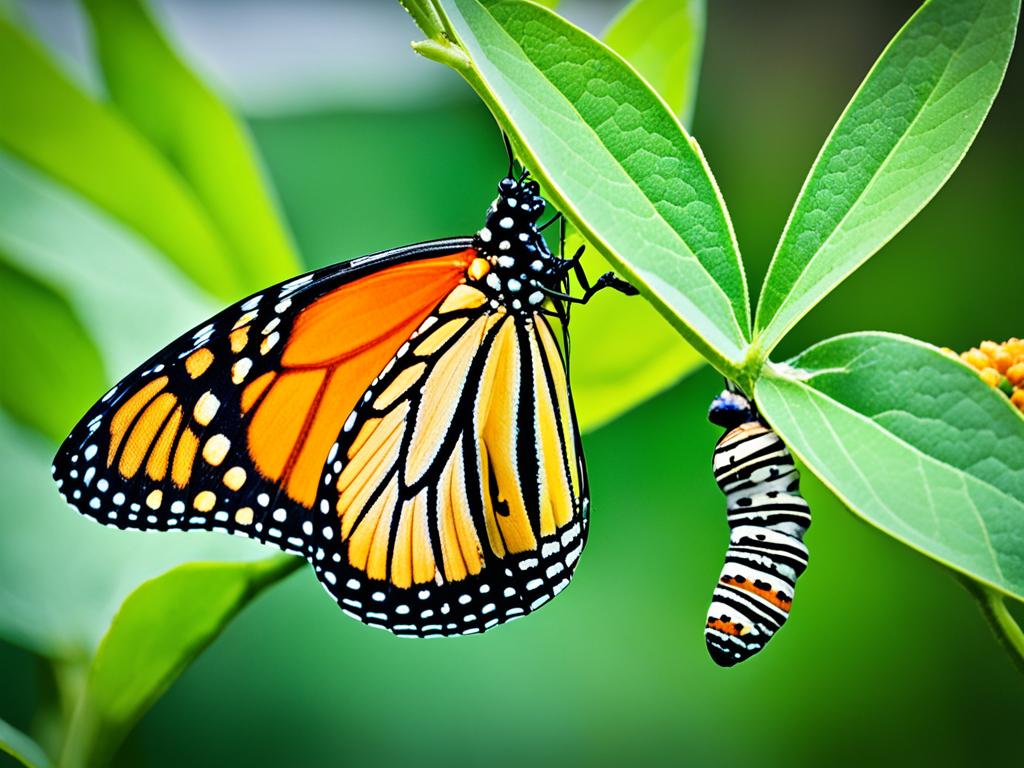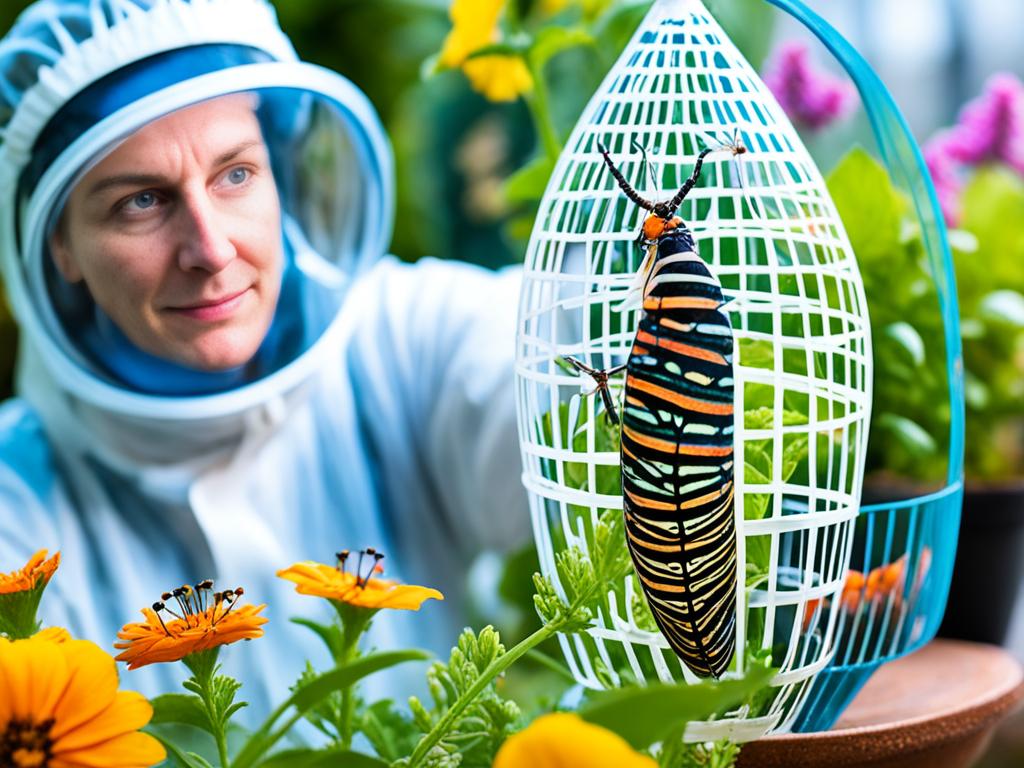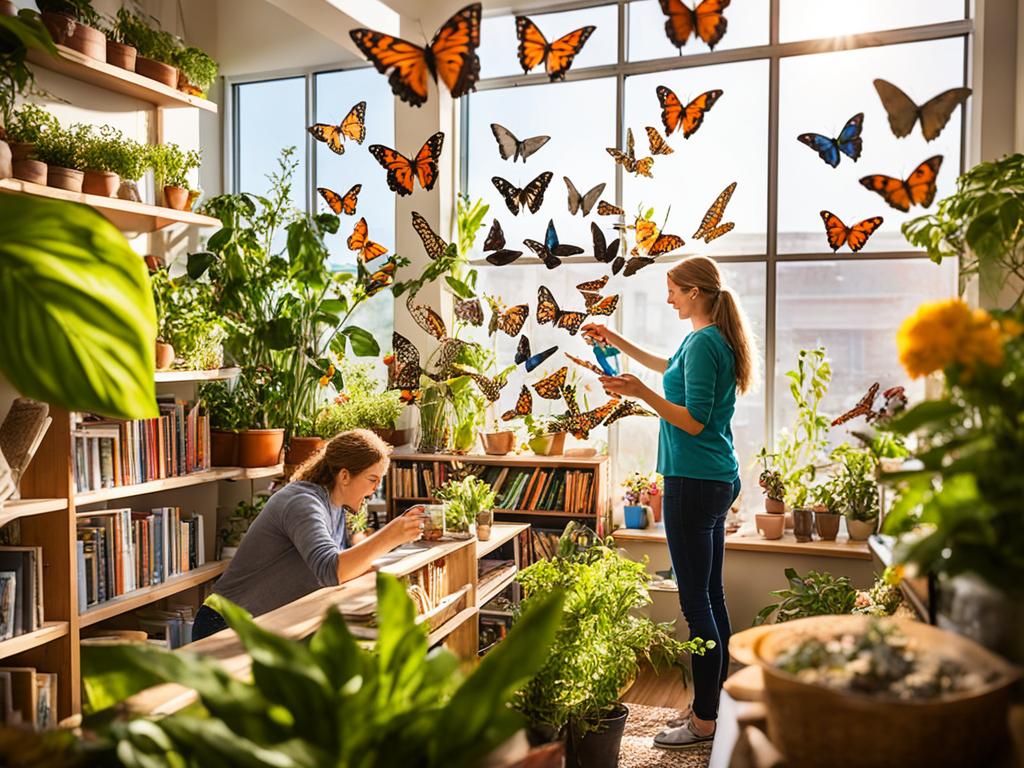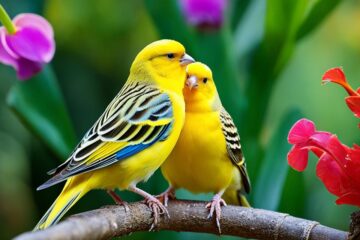Imagine stepping into a peaceful oasis, surrounded by vibrant colors and gentle fluttering wings. The air is filled with the delicate fragrance of flowers, while the soothing hum of nature’s orchestra plays in the background. This is the enchanting world of indoor butterfly gardens, where you can witness the miraculous transformation of tiny caterpillars into magnificent butterflies.
For those seeking a connection with nature and a sense of wonder, raising butterflies indoors is a truly magical experience. Not only does it bring beauty and tranquility into your home, but it also provides a valuable opportunity to learn about these extraordinary creatures and contribute to their conservation.
Key Takeaways:
- Create an indoor butterfly habitat to provide a safe and nurturing environment for these delicate creatures.
- Understand the fascinating butterfly lifecycle and consider raising monarch butterflies for a unique experience.
- Take proper care of your butterflies by providing essential elements such as food, water, and natural surroundings.
- Explore the joys of butterfly farming while contributing to butterfly conservation efforts.
- By creating an indoor butterfly oasis, you can experience the beauty and wonder of these winged wonders up close.
Creating an Indoor Butterfly Habitat
Designing an ideal indoor butterfly habitat is crucial for the well-being and happiness of your delicate winged companions. By providing the right conditions and elements, you can create a haven that emulates their natural environment and encourages their fluttering beauty. Let’s explore the essentials of creating the perfect butterfly habitat within your home.
Temperature and Humidity
The right temperature and humidity levels are vital for the health and thriving of your indoor butterflies. Most butterfly species require a temperature range of 75-85°F (24-29°C). To maintain a suitable environment, it’s advisable to place the butterfly enclosure away from direct sunlight and drafts that can cause dramatic temperature fluctuations. It’s essential to monitor the humidity levels closely as well, aiming for approximately 60-80% humidity to mimic their natural butterfly habitat conditions.
Lighting and Ventilation
Proper lighting and ventilation are crucial factors in creating a conducive indoor butterfly environment. The right balance of natural light and artificial lighting is essential to mimic their natural habitats. Position the enclosure in a well-lit area, preferably with indirect sunlight. Supplement natural light with fluorescent or LED lights, ensuring a daily light exposure of 12-14 hours.
Ventilation plays a pivotal role in maintaining air circulation that prevents stagnation and excessive moisture. Adequate airflow helps to control humidity levels and reduce the risk of fungal growth. Choose an enclosure with mesh or breathable walls to facilitate proper ventilation within the indoor butterfly enclosure.
Selecting the Right Enclosure
Choosing the right enclosure is essential for the comfort and safety of your indoor butterflies. Opt for a spacious and well-ventilated enclosure that allows ample room for flying and perching. The enclosure should have a secure lid or cover to prevent escapes while still providing easy access for maintenance and feeding.
Natural Elements
Creating a lush and inviting space for your butterflies entails incorporating natural elements within their enclosure. Introduce potted plants and flowers that provide nectar and offer perching spots. Some ideal plant choices include milkweed, butterfly bush, and zinnias. These plants not only enhance the aesthetic appeal but also serve as a source of food and shelter for your delicate residents.
Creating an indoor butterfly habitat involves careful attention to detail, emulating the natural butterfly habitat while ensuring their safety and comfort. By providing the right temperature, humidity, lighting, ventilation, and natural elements, you can create a thriving environment that inspires these mesmerizing creatures to spread their delicate wings.
Next, let’s explore the intricate and captivating world of the butterfly lifecycle and the wonders of raising monarch butterflies indoors.
Understanding the Butterfly Lifecycle
The journey of a butterfly, from a humble egg to a magnificent winged creature, is an awe-inspiring process. Understanding the butterfly lifecycle is essential for anyone interested in raising monarch butterflies or exploring the beautiful world of butterfly rearing.
Egg: It all begins with a tiny, delicate egg. Typically laid on the underside of a leaf, butterfly eggs are a sight to behold. These tiny structures hold the promise of new life and eventually hatch into caterpillars.
Caterpillar: Once hatched, the caterpillar emerges, ready to devour plant matter and grow rapidly. Known for their voracious appetite, caterpillars go through multiple molts, shedding their exoskeletons as they grow. This stage is crucial for the caterpillar’s development.
Pupa: As the caterpillar reaches maturity, it enters the pupa stage. Inside a chrysalis, a miraculous transformation takes place. The caterpillar’s tissues break down and reorganize, forming the body of a butterfly. It is a remarkable process of metamorphosis.
Emerging Butterfly: Finally, the time comes for the butterfly to emerge from its chrysalis. It carefully pumps fluid into its wings, allowing them to unfurl and expand. Once its wings are dry, the butterfly takes its first flight, ready to embark on its remarkable journey.
Raising monarch butterflies holds a special place in the hearts of butterfly enthusiasts. Monarchs are known for their vibrant orange and black wings and their incredible migration patterns. By understanding the unique lifecycle of monarch butterflies, one can take part in their conservation efforts and contribute to their survival.
Now, let’s take a closer look at the lifecycle of monarch butterflies through an informative table:
| Stage | Description |
|---|---|
| Egg | Tiny, laid on the underside of a leaf |
| Caterpillar | Rapid growth through multiple molts |
| Pupa | Transformation inside a chrysalis |
| Butterfly | Emerges from the chrysalis and begins its magnificent journey |

By raising monarch butterflies and witnessing their remarkable lifecycle firsthand, enthusiasts not only gain a deeper appreciation for these enchanting creatures but also contribute to the conservation of their species. The wonders of the butterfly lifecycle continue to inspire and captivate, reminding us of the beauty and resilience of nature.
Butterfly Care and Maintenance
Proper care and maintenance are crucial when raising butterflies indoors. Creating a nurturing environment ensures their well-being and allows you to witness the miraculous transformation from caterpillars to beautiful butterflies. In this section, we will explore essential practices for butterfly care, the art of butterfly farming, and the significance of butterfly conservation efforts.
Feeding and Nutrition
Providing the right food and nutrition is vital for the health and development of your indoor butterflies. Different butterfly species have specific dietary requirements, so research their preferred plants and flowers to offer a suitable menu. Incorporate a variety of nectar-rich flowers, such as milkweed for monarch butterflies, to sustain them throughout their lifecycle. Remember to regularly replenish their food sources to ensure they receive an adequate supply.
Watering and Hydration
While butterflies primarily obtain moisture from nectar, they also require water for hydration. Create a shallow water source by placing a small dish or saucer with wet sand or pebbles in the enclosure. This allows the butterflies to extract moisture without the risk of drowning. Ensure the water source is clean and refreshed regularly to maintain a hygienic environment for your delicate guests.
The Art of Butterfly Farming
Butterfly farming involves the intentional rearing and breeding of butterflies for various purposes, including education, research, and conservation. It provides a sustainable way to meet the demand for butterflies while protecting wild populations. Through careful breeding and responsible farming practices, butterfly farmers contribute to the preservation of these mesmerizing creatures.
“Butterfly farming allows us to appreciate the beauty of butterflies while supporting their conservation. By cultivating these delicate creatures in controlled environments, we reduce the need for wild capture and contribute to their overall protection.” – Butterfly enthusiast
Butterfly Conservation
Butterflies play a crucial role as pollinators and indicators of environmental health. Unfortunately, habitat loss, climate change, and pesticide use threaten their populations. Engaging in butterfly conservation efforts is essential to safeguard their survival. You can contribute by creating butterfly-friendly habitats, planting native flowers, avoiding chemical pesticides, and supporting organizations dedicated to butterfly conservation.
To learn more about butterfly care, butterfly farming, and butterfly conservation, visit this comprehensive guide on butterfly pets. It offers valuable insights and practical tips for creating a thriving butterfly haven in your own home.

Conclusion
Throughout this guide, we have explored the exciting world of raising butterflies indoors. By creating a safe and nurturing habitat, you can experience the joy and fulfillment of witnessing these winged wonders up close.
Remember, creating an indoor butterfly habitat involves careful attention to temperature, humidity, lighting, and ventilation. Incorporating natural elements such as plants and flowers will provide a familiar and enriching environment for the butterflies to thrive. If you’re looking for inspiration or more information, check out the Winged Wonders: Butterfly House at the N.C. Arboretum, a living exhibit that showcases the beauty of these delicate creatures.
Understanding the butterfly lifecycle is essential for successful indoor butterfly raising. From the tiny eggs to the transformative journey of the caterpillars and the emergence of magnificent butterflies, each stage is a testament to the wonder of nature. Monarch butterflies, in particular, offer a unique experience to witness their remarkable migration. For resources and ideas on raising monarch butterflies, visit https://growforit.ces.ncsu.edu/activities-for-kids/raising-painted-lady-butterflies/.
Taking care of butterflies requires attention to their feeding, watering, and overall nutrition. Whether you are engaging in butterfly farming or simply enjoying these enchanting creatures, it is crucial to support butterfly conservation efforts. By creating indoor butterfly habitats, we contribute to the preservation of their fragile ecosystems and help sustain the beauty of butterflies for future generations.




